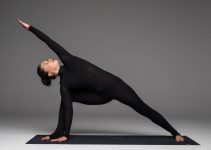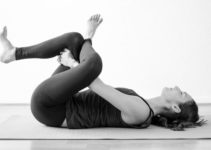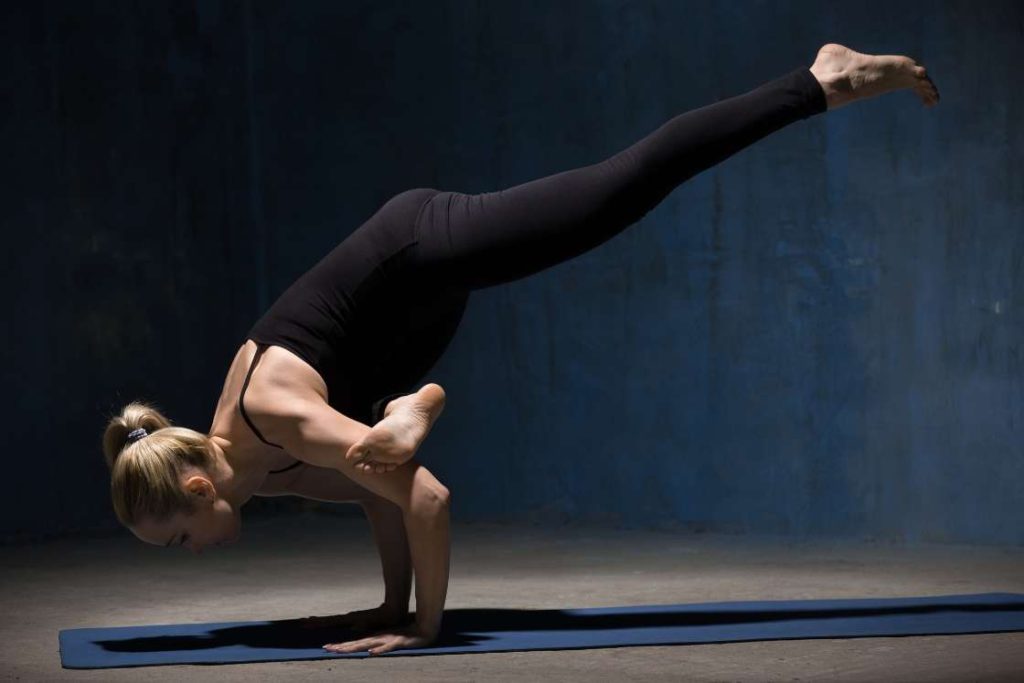
| Sanskrit Pronunciation | Eka Pada Galavasana (eh-KAH pad-DAH-GaL-VAA-sun-Aa) |
| Meaning | Eka = one / Pada = foot / Galava = an ancient sage / asana = pose |
| Pose Type | Arm balancing forward bend |
| Pose Level | Advanced |
| Focused body part | Hamstring, thighs, pelvic, glutes, hip flexors, shoulder, forearms, wrist, ankle, knees |
| Other Names | Pyramid pose, Intense side stretch pose, side flank intense stretch, single-leg forward bend. |
Eka Pada Galavasana is an arm balancing pose practiced in Hatha and 3rd series of Ashtanga Yoga. It focuses on strengthening arm, shoulder, and core muscles.
The pose Eka Pada Galavasana is assumed as an advanced variation of the Pigeon pose. Here the legs are kept in a similar position as in the half pigeon pose. And then with pigeon legs, the body is lifted off the floor.
Eka Pada Galavasana Meaning
Galavasana in the pose name is after an ancient sage ‘Galava’. ‘Eka‘ means ‘one’, ‘Pada‘ means ‘foot’, ‘Galava‘ is the name of an ancient sage, and ‘asana‘ means ‘Pose’.
In Eka Pada Galavasana, the practitioners balanced the body on arms with one foot raised in the air. Hence it’s called the Flying pigeon pose. The flying aspect of the pose is named after Sage Galava because of his austerity.
Story Of Ancient Sage Galava
According to Hindu legends, Galava was the powerful ancient Sage in the Dwapara Yuga (Third out of Four ages as per Hinduism). He was the disciple of the ‘Vishwamitra’ and was greatly known for his Guru Bhakti (Practice of Devotion). By praying to the lord Garuda, Galava had brought a majestic white horse as a present for his guru Vishwamitra as he got Vedic knowledge from him. To which, Vishwamitra returned the horse by seeing his immense devotion and respect toward him. Vishwamitra took Galava to king Mandala along with him for the meditation practice. Now, it is believed that since then both of them are practicing meditation on lord shiva in Rishi Mandala.
Hence, practicing Eka Pada Galvasana not only refines strength and balance but also affects mental and psychological framing. This leads to the concentration and attention power that helps in meditation practice for a longer period.
Practice Guide
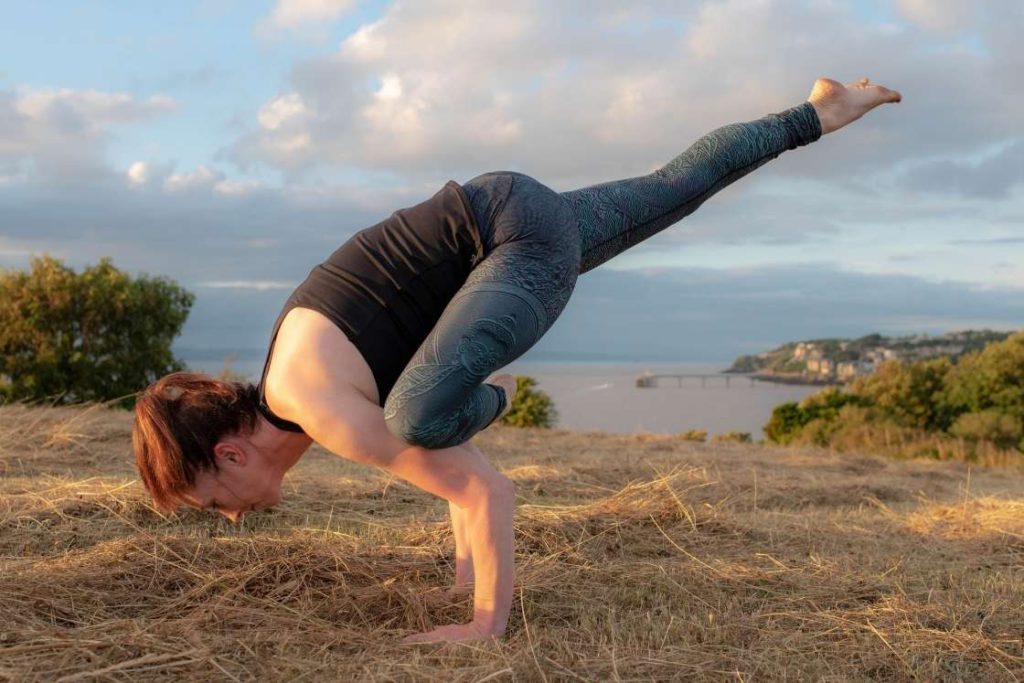
To gain a wider insight into the physical, mental and spiritual possibilities for the body, practitioners can go through the following steps. This is the safe path to begin the Flying Pigeon Pose.
Contraindications of Eka Pada Galvasana
Practitioners with sciatic nerve conditions avoid doing this asana. Also, in case of injuries of hands, feet, hips, neck, legs, knees, spine, or ankles refrain from the practice. Women should avoid this pose in pregnancy, menstruation, and in recent surgeries of the abdomen, waist, and any crucial joint. One should immediately return on experiencing a headache and dizziness while practicing Flying Pigeon Pose.
Preparatory Poses
- Supta Kapotasana (Reclining pigeon pose)
- Eka Pada Rajakapotasana (One-Legged King Pigeon Pose)
- Bakasana (Crow Pose)
How to Do Flying Pigeon Pose (Steps)
- Begin by coming into Tadasana. Hands beside the hips and foot apart with hip distance.
- Now, drop your pelvis by micro bending your knees. Press feet firmly down with fingers spread gripping the floor. Here the body is in the chair pose position.
- After that, lift your right foot with the help of one hand and balance with the other to place it on the left thigh. Raise your arms up and palms facing each other.
- Now inhale, and with an exhalation bend forward in the manner, your sternum touches the right calf and hands parallel in forwarding direction. Gaze down to the floor.
- From here, reach the floor and place your palms on the floor. Fix your right ankle under the left armpit and foot beside the left triceps. Take your right leg shin as high as possible under the right arm.
- Now, squeeze in your elbows to lean forward. Then slightly bend your elbows and simultaneously lift off the left foot from the floor. Try to pull the left foot toward the gluts and foot pointing in the upward direction.
- Gradually, spread the fingers to lean a bit deeper in the forward bend. Then straighten the left leg up and foot pointing in the same direction while the right foot resting the left triceps.
- Maintain here as long as it is comfortable and slowly bring the left leg back to come out of the pose. Lean backdrop the left foot on the floor and return on both legs. Lift up the pelvis and hands dropped to come into the Tadasana and then relax.
Follow Up Poses
Eka Pada Galvasana is an intense powerful pose. It engage body in forward bend and requires bodily strength to hold the pose. Do these follow up poses after practicing this intense pose to the relax the body;
Precautions
When performing the flying pigeon pose, these precautionary points should be keep in mind to avoid any injury and safe practice.
- After chair pose, while lifting the right leg to place it on the left thigh Practitioners should avoid using both hands. This could result in falling to either side due to an imbalance in the flying pigeon pose.
- While lifting the body off the floor, lengthen your spine in order to place the right ankle under the armpit and foot firmly over the left triceps. This will prevent the leg from slipping while balancing the pose on the hands.
- Taking the left leg higher in the air requires strength in the hand and shoulder. Lose placement of hands might result in mishappening. So, one should aware of their upper body strength while taking off in a Flying pigeon pose.
Beginners Tips
Using props for modifications beginners can get easy balancing sense in Eka Pada Galvasana. Moreover, these beginner tips would be helpful for a person who’s finding it tough to balance the body in the flying pigeon pose.
- Practitioners should avoid dropping off the head while taking the back leg up. This creates a gravitational pull toward the floor, which could cause falling by the head. So, by using the weight of the back leg and torso, practitioners can balance their center of gravity. This will avoid pressure on the head and ultimately falling forward.
- Beginners who have no history of balancing might be having difficulty in practicing flying pigeon pose initially. This could be due to a lack of strength and flexibility in the wrist.
Variations of Flying Pigeon Pose
When you get comfortable with moving body, you can aim for these two variations of the flying pigeon pose. One-Legged Revolved flying Pigeon Pose and One-Legged Crow Pose.
1. One-Legged Revolved flying Pigeon Pose (Eka Danda Galvasana)
Here, the limbs along the same side placed on the respective hand’s triceps and other legs are straightened back. Whereas, In the flying pigeon pose, the right foot is placed on the left-hand triceps and the left leg remains straight up in the air.
The one-legged flying pigeon pose is the first variation of the Flying pose. In this pose, the body is held upon both palms. The left leg is placed on the triceps of the left leg with a torso twisted in the left and the right leg remains straight behind, gaze in the front direction.
2. One-Legged Crow Pose (Eka Pada Bakasana)
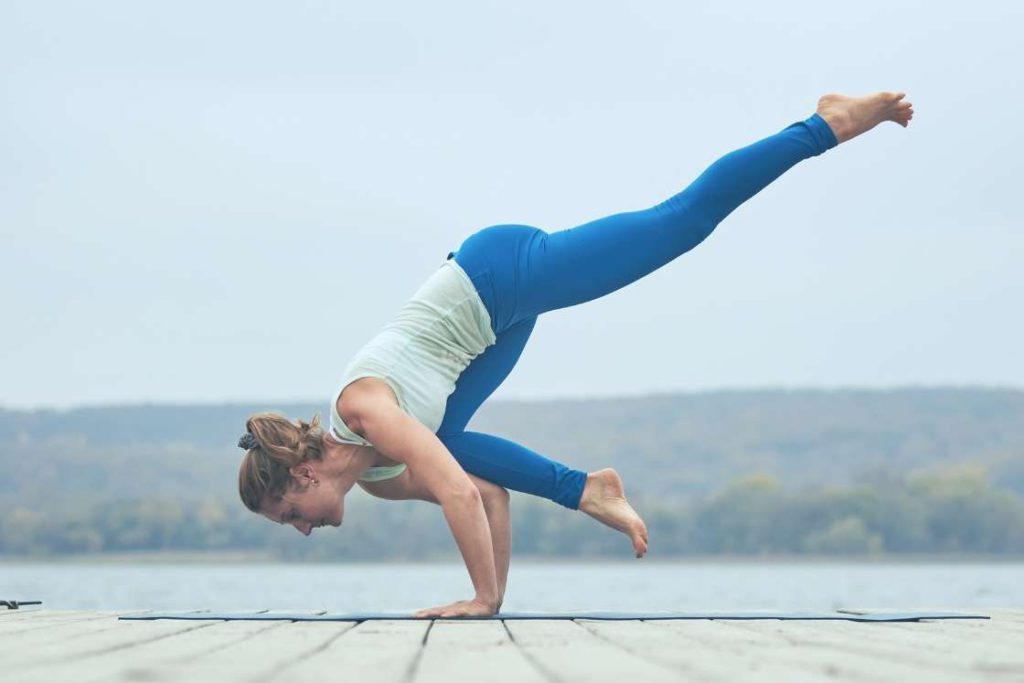
This is another variation for the Flying pigeon pose. In this hand balancing pose, the left leg of the practitioner rests on the left upper hand. The right leg remains straight in the air while the head gazes down to the floor.
In the Flying pigeon pose, the right ankle is placed beneath the right armpit, and the right foot placed on the right triceps. The left leg is lifted above toward the ceiling side while the body balances on the floor. Whereas, In one-legged crow pose, the left knee rests on the left upper hand and the right leg remains up in the air.
Therapeutic Use
- Good for pelvic floor muscles – The Pelvic floor muscles support the bladder, uterus, and bowel, which due to obesity, childbirth, and chronic constipation become weaker. This results in urinary and reproductive disorders like leaking of urine and delay inability to ejaculate.
The regular practice of the Flying pigeon pose strengthens pelvic floor muscles. This prevents urine from leakage while coughing and sneezing, also promotes normal ejaculation. - Promotes relaxation in hip joint – Opens Lack of activity and prolonged sitting result in tight hip muscles. This reduces flexibility and creates situations prone to injury. The practice of flying pigeon pose stretches the groin and pelvic region. This promotes hip extension, necessary to run and jump. It also helps in the full flexion required to squat and to perform heavy lifting.
Eka Pada Galvasana Benefits
When performed correctly, the pose enhances the mental focus, strengthens the wrist, core, and shoulder muscles. It gives the spine a gentle stretch in the pull of gravity.
Below are some major and detailed benefits of flying pigeon pose.
1. Strengthens Upper Body And Core Muscles
The flying Pigeon pose practice lay immense pressure on the upper framework of the body. This tears up the muscles, which after getting rest reform themselves stronger than before. The pressure enhances the calcium absorption from the blood by the bones. This makes them solid and strengthens them. Hence, regular practice of this pose improves the overall musculoskeletal framework to build the upper body.
2. Boost Up the Mental Focus
The Eka Pada Galavasana is a challenging pose, which increases oxygen consumption that makes the heart distribute blood faster, and activates sweat glands. According to one of the research [efn_note] Regular exercise changes the brain to improve memory, thinking skills https://www.health.harvard.edu/blog/regular-exercise-changes-brain-improve-memory-thinking-skills-201404097110 [/efn_note], physical movements affect the heart and sweat glands in this manner. Results in boosting the size of the hippocampus, which is responsible for verbal memory and learning. Hence, improves mental focus.
3. Activates Ajna Chakra
Eka Pada Galavasana considered best pose to activate Ajna chakra. It stimulates the flow of prana in the subtle channel if practiced with proper alignment and right breathing techniques. This results in the activation of Ajna (Third eye) Chakra and it is associated with higher knowledge, the subtler aspects of sight, and intuition.
4. Maintains Cardiopulmonary Health
In flying pigeon pose, the heart pumps blood into the circulation more efficiently as a result of more forceful and efficient myocardial contraction, increased perfusion of tissues and organs with blood, and increased oxygen delivery. According to one of the research [efn_note] Cardio-Pulmonary Physiology during Yoga Inversion Practice https://www.spotlightonresearch.com/yoga-research/cardio-pulmonary-physiology-during-yoga-inversion-practice [/efn_note] inversion in the flying pigeon pose maintains cardiopulmonary health in the practitioners.
5. Promotes overall Health in Females
Regular practice regulates the metabolism of the practitioners. This results in various improvements in the body including abdominal fat, blood lipid resistance, blood glucose, and insulin resistance. However, this also improves the menstrual cycle ovulation and fertility, decreases testosterone levels and Free Androgen Index (FAI), and increases sex hormone-binding globulin (SHBG). Hence, promotes overall health.
6. Overcomes Stress and Anxiety
Regular practice of the Flying pigeon pose reduces the level of stress hormones like adrenaline and cortisol in the bloodstream. However, it also stimulates the production of endorphins, chemicals in the brain that are the body’s natural painkillers and mood elevators. Hence, overcomes stress and anxiety.
Conclusion
The Flying pigeon pose is an effective pose for the strengthening of the upper body. This also improves the pelvic flexibility that helps in urinary and reproductive disorders. Proper alignment activates Ajna chakra which further unblocks the spiritual perspective of the practitioner toward the world.
This pose is one of the challenging ones and it is better to be practiced under a skilled yoga teacher. However, with practice, anyone can adapt himself/herself to this pose.
